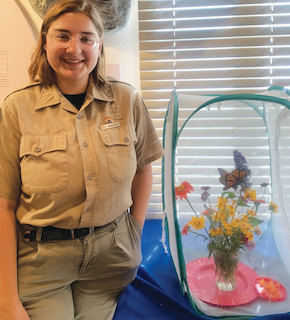Lily Aravanis is fielding visitor questions, selling butterfly paraphernalia and on this Wednesday afternoon talking to a reporter all at once—still, she doesn’t skip a beat as she says that there are an estimated 3,500 monarch butterflies at Natural Bridges State Beach.
It’s the busiest time of the year for the small visitor center according to Aravanis, a marine biologist who works behind the desk at Natural Bridges.
From the end of October to December, people from around the world come to see the monarch butterflies that are flying around Santa Cruz, concentrated in a few groves around the city. It’s only 1pm and the Natural Bridges gift shop and visitor center has been open for an hour, but already Aravanis says she has helped around 130 customers.
This is the best time of year to see the butterflies, Aravanis says, as they are still out flying from plant to plant as they try and stock up on food before going into hibernation.
“They’re still in their stage where they’re trying to fatten up as much as they can, so you’ll see some clusters, but you’ll also see them flying,” Aravanis says.
The butterflies will continue to arrive in the city and gather in groves up until the end of November, when they go into hibernation. Last year around this time there were an estimated 7,000 monarchs, but Aravanis is optimistic with the number of butterflies staff has counted in the groves so far—especially considering the storms earlier this year.
Before January of this year, Santa Cruz had around 8,000 monarchs hibernating throughout the city. After the series of storms that began New Year’s Eve last year, that count dropped to around 2500. Aravanis says that the drop in numbers could have been attributed to various factors, not all related to death: some monarchs could have blown to different areas, for instance.
Still, overall trends show the monarch population declining—largely as a consequence of climate change causing weather extremes, like wildfires and storms.
“Monarch butterflies are kind of like Goldilocks,” Aravanis says. “They really need an area that’s not too hot, not too cold. So if you start getting areas with more extreme weather patterns, then there’s going to be less places for them to survive.”
When Monarchs go into hibernation in winter months, Aravanis explains, they do so to conserve their energy to continue their trek down the state and into Mexico. More extreme weather likely means more movement—which, when considering that the butterflies migrate from as far north as Canada to central Mexico, can mean life or death.
“They have huge migrations, it’s a lot for a person to do that distance, and they’re butterflies,” Aravanis says. “They have a lot of environmental factors that are working against them, but they persist anyways.”
The other challenge is habitat loss, she says.
“We need to be protecting our groves making sure that they’re not being cut down, or the trees when they fall down that they’re replaced,” she says.
Aravanis, who graduated from UC Santa Cruz and would spend her spare time examining the tide pools at Natural Bridges, says that before she worked at the visitor center, she didn’t appreciate the butterflies as much.
“I didn’t realize just how cool it was. But the butterflies are really special. There’s something about them and like I have a science brain I don’t use the term magical lightly,” she says. “But there’s something about hanging out down the grove and watching the butterflies and it really kind of is magical.”














what an amazing and informational article!